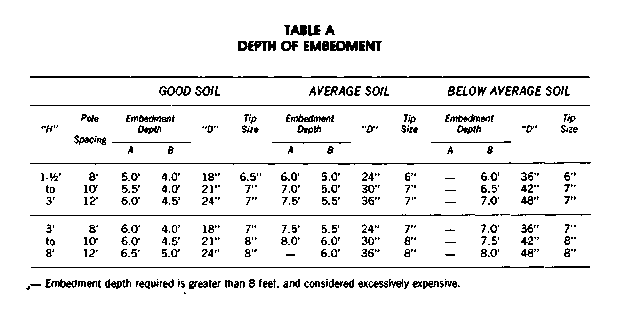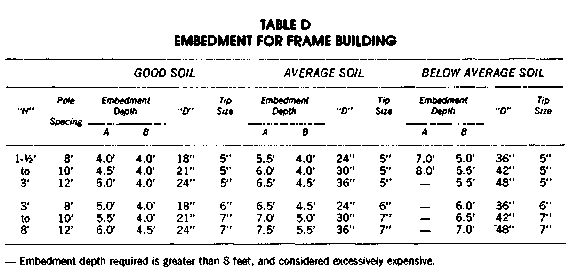|
The first thing to consider even before starting to dig, is the general soil condition of the site; secondly its grade. In general for any pole building, the soil is considered below average if it is soft clay, poorly compacted sand, or clay containing large amounts of silt (with water standing during a wet period). Average soil is compact, well-graded sand and gravel, hard clay or graded fine and coarse sand. Pole buildings based on the criteria in Table A are suitable on sites that are flat or with a grade of less than 1 in 10. In all the Tables: H= Unsupported height of poles (from ground to first cross member). |
A = Embedment depth, using backfill or tamped earth, sand, gravel or crushed rock. B = Embedment depth, using backfill of concrete or soil cement. D = Bearing Diameter (size of pad). Pole buildings based on the criteria shown in Tables B and C can be built on sites with slopes as steep as 1 in 1, provided there is no danger from landslides. Table B shows the embedment depths for the longer, downhill poles, which carry only vertical loads. Table C shows the criteria for the uphill line of poles in a steep site, that must be embedded adequately to resist lateral as well as vertical loads. |
|||
 |
||||
| TABLE B SLOPE EMBEDMENT | |||||||||||||||||||||||||||||||||||||||||||||||||||||||||||||||||||||||||||||||||||||||||||||||||||||||||||||||||||||||||||||||||||||||||||||||||||||||||||||||||||||||||||||||||||||||||||||||||||||||||||||||||||||||||||||||||||||||||||||||||||
| Soil Strength | Up to 1:3 | SLOPE OF GRADE Up to 1:2 | Up tO 1:1 | ||||||||||||||||||||||||||||||||||||||||||||||||||||||||||||||||||||||||||||||||||||||||||||||||||||||||||||||||||||||||||||||||||||||||||||||||||||||||||||||||||||||||||||||||||||||||||||||||||||||||||||||||||||||||||||||||||||||||||||||||
| Below Average Average Good |
4,5′ 4.0′ 4.0′ |
6.0′ 5.0′ 4.0′ |
7.0′ 6.0′ | ||||||||||||||||||||||||||||||||||||||||||||||||||||||||||||||||||||||||||||||||||||||||||||||||||||||||||||||||||||||||||||||||||||||||||||||||||||||||||||||||||||||||||||||||||||||||||||||||||||||||||||||||||||||||||||||||||||||||||||||||
| TABLE C SPACING & DEPTH RELATIONS | |||||||||||||||||||||||||||||||||||||||||||||||||||||||||||||||||||||||||||||||||||||||||||||||||||||||||||||||||||||||||||||||||||||||||||||||||||||||||||||||||||||||||||||||||||||||||||||||||||||||||||||||||||||||||||||||||||||||||||||||||||
| GOOD SOIL | AVERAGE SOIL | BELOW AVERAGE SOIL | |||||||||||||||||||||||||||||||||||||||||||||||||||||||||||||||||||||||||||||||||||||||||||||||||||||||||||||||||||||||||||||||||||||||||||||||||||||||||||||||||||||||||||||||||||||||||||||||||||||||||||||||||||||||||||||||||||||||||||||||||
|
|||||||||||||||||||||||||||||||||||||||||||||||||||||||||||||||||||||||||||||||||||||||||||||||||||||||||||||||||||||||||||||||||||||||||||||||||||||||||||||||||||||||||||||||||||||||||||||||||||||||||||||||||||||||||||||||||||||||||||||||||||
| — Embedment depth required is greater than 8 feet, and considered excessively expensive. * These tip diameters may be decreased by one inch providing embedment is increased by one-halt foot. |
|||||||||||||||||||||||||||||||||||||||||||||||||||||||||||||||||||||||||||||||||||||||||||||||||||||||||||||||||||||||||||||||||||||||||||||||||||||||||||||||||||||||||||||||||||||||||||||||||||||||||||||||||||||||||||||||||||||||||||||||||||
|
|||||||||||||||||||||||||||||||||||||||||||||||||||||||||||||||||||||||||||||||||||||||||||||||||||||||||||||||||||||||||||||||||||||||||||||||||||||||||||||||||||||||||||||||||||||||||||||||||||||||||||||||||||||||||||||||||||||||||||||||||||

